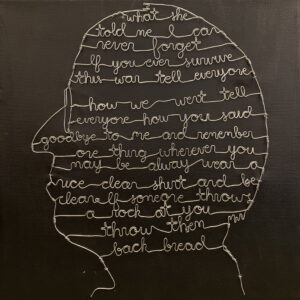“…If you ever survive this war tell everyone how we went. Tell everyone how you said good-bye to me and remember one thing. Wherever you may be always wear a nice clean shirt and be clean. If someone throws a rock at you then throw them back bread.”
These are the words that Holocaust survivor Maurice Markheim will never forget. They comprise the indelible message that is etched into his memory as the last conversation he had with his mother. 
When we viewed this piece, we were struck by these poignant and heartfelt words of love and kindness as well as the way in which Evan Hong, an eighth grader at Mariners Christian School in Costa Mesa, California, memorialized them by creating a wire silhouette as an art project her school submitted for Chapman University’s 21st Annual Holocaust Art and Writing Contest.
Last year, thousands of middle and high school students from across the United States and seven other countries, watched survivor video testimonies and responded to the contest prompt through prose, poetry, art, or film. This year’s contest, now in its 22nd year, challenges students to reflect upon and interpret the theme, “Sharing Strength: Sustaining Humanity.”
To prepare students to participate in the contest, many teachers turn to Echoes & Reflections, a valued partner in the contest, for professional development and to help them provide historical context to the testimonies that students watch. This year, Chapman University will team up with Echoes & Reflections to offer a contest-specific professional development program to highlight key resources that align with the contest, as well as effective strategies to further student engagement with the testimonies they view.
In our respective roles as the Associate Director and Education Consultant for the Rodgers Center at Chapman University, we have seen the contest grow tremendously over the years. What we think continues to be particularly appealing and, perhaps why many teachers participate year after year, is the contest’s way of combining study of the Holocaust with the hands-on participation in the arts, offering students a platform and a voice to process and express their thoughts and reactions and to make their own, individual meaning.
In fact, this contest might offer even greater benefits to those participating. Authors Brian Kisida and Daniel H. Bowen, write in their Brookings Institute blog, New Evidence of the Benefits of Arts Education, that participation in the arts challenge us with different points of view, compel students to empathize with “others,” and give us the opportunity to reflect on the human condition.1
For example, Noa Nerwich, a middle school student from King David Linksfield School in South Africa, drafted the following poem based on the testimony of Holocaust survivor Ruth Halbreich. It examines how a simple, everyday object, a “Maroon Hankie,” became a meaningful, everlasting and valued connection to her father.
Cleanly pressed and folded it was placed into my hand
A last token of a soon to be memory
I received a maroon hankie
I didn’t know the value of objects, until had one
I didn’t know the value of people, until I had none.
But my one object carried all the worth in the world
A maroon hankie
I don’t know what happened to him
All I know is the walls were rising
And there were bombs, more people dying
And Warsaw was in flames: Red, licking flames
Like the colour of my maroon hankie
We watched the window, havoc unleashed on our home
Yet we were the opportune, we were on the right side of the window pane
The side where we still wore silky dresses made by the sisters.
The same silk of my maroon hankie.
I was lucky
Not because I was saved
But because I learned the true meaning of love
His love was sewn into my heart
The same way I held the hankie so tight at night
That its fibers have sewn into the fibers of my skin
Because of my father’s honour I survived
Because of his love for us he died
He sacrificed it all so we could breathe the air of freedom
To the man who gave to me
The thing that has carried all of my tears
A maroon hankie
His maroon hankie
This year as we commemorated the 75th anniversary of the liberation of the camps we were reminded that today’s students are the last generation to hear directly from the survivors. As we look to the future, one of the lasting artifacts we have are the survivors’ precious video testimonies, a permanent record that captures their stories, warnings, and memories. The testimonies also stand as the fulfillment of a promise that the eyewitnesses made to each other during the Holocaust, in which they vowed if they survived to tell the story, to let the world know what happened and to do their utmost to assure that these events would never be forgotten. Students who participate in the contest have now become their “messengers of memory,” the ones entrusted with perpetuating this vow for generations to come and, as a recent survey has shown, their exposure to Holocaust survivor testimony can support them in building a better future.
This year’s contest information is now available and educators are invited to participate.
For more information: Annual Holocaust Art & Writing Contest
Contact: Jessica MyLymuk at cioffi@chapman.edu, (714) 532-6003
Note: Last year, Chapman University had to cancel its 21st Annual Holocaust Art & Writing Contest awards ceremony, which was scheduled on March 13, 2020, due to the Coronavirus. A virtual program is posted on the contest website and can be watched here.
About the authors:
Jessica MyLymuk is the Associate Director at the Rodgers Center for Holocaust Education at Chapman University and oversees the planning and implementation for the Annual Holocaust Art & Writing Contest.
Sherry Bard is an Education Consultant for the Rodgers Center for Holocaust Education and a Senior Training Specialist for the Echoes & Reflections program.


